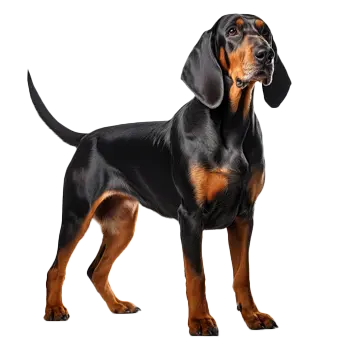The American Black and Tan Coonhound is generally a hardy breed with a typical lifespan of ten to twelve years, though individual dogs may live longer or shorter lives depending on genetics, care, and environmental factors. Responsible breeders screen their breeding stock for hereditary health conditions to reduce the likelihood of producing affected puppies. Prospective owners should ask breeders about health testing performed on parent dogs and request documentation of clearances from organizations such as the Orthopedic Foundation for Animals.
Hip dysplasia represents one of the most common orthopedic concerns in the American Black and Tan Coonhound. This hereditary condition occurs when the hip joint does not develop properly, resulting in joint laxity, abnormal wear, and progressive arthritis over time. Affected dogs may show signs such as difficulty rising from a resting position, reluctance to jump or climb stairs, reduced activity level, or an abnormal gait. Mild cases may be managed through weight management, anti-inflammatory medications, and joint supplements, while severe cases might require surgical intervention to improve the dog's quality of life.
Bloat, medically known as gastric dilatation-volvulus, is a life-threatening emergency condition that can affect the American Black and Tan Coonhound and other deep-chested breeds. This condition occurs when the stomach fills with gas and potentially rotates on itself, cutting off blood flow and preventing the dog from relieving the gas through vomiting or belching. Symptoms include a distended abdomen, unproductive attempts to vomit, excessive drooling, restlessness, and signs of pain or distress. Bloat requires immediate emergency veterinary treatment, as the condition can rapidly progress to shock and death within hours if not addressed. Preventive measures include feeding smaller meals multiple times daily rather than one large meal, avoiding vigorous exercise immediately before or after meals, using elevated food bowls, and avoiding foods that produce excessive gas.
Ear infections are a common health issue in the American Black and Tan Coonhound due to the breed's long, pendulous ears that create a warm, moist environment conducive to bacterial and yeast growth. Regular ear cleaning and inspection help prevent infections from developing. Signs of ear infection include head shaking, ear scratching, redness inside the ear, unusual odor, and discharge. Prompt veterinary treatment prevents minor infections from becoming chronic problems that might cause permanent damage to the ear canal or hearing.
Hypothyroidism can affect the American Black and Tan Coonhound, occurring when the thyroid gland does not produce adequate amounts of thyroid hormone. Symptoms may include unexplained weight gain, lethargy, skin problems, hair loss, and cold intolerance. Fortunately, hypothyroidism is easily diagnosed through blood testing and managed effectively with daily thyroid hormone supplementation. Dogs receiving appropriate treatment typically return to normal health and can live full, active lives.
Regular veterinary care forms the foundation of maintaining the American Black and Tan Coonhound's health throughout their life. Annual wellness examinations allow veterinarians to detect potential problems early when they are most treatable. Core vaccinations protect against serious infectious diseases such as distemper, parvovirus, and rabies, while other vaccines may be recommended based on the dog's lifestyle and geographic location. Parasite prevention, including treatments for heartworms, fleas, and ticks, should be maintained year-round as recommended by your veterinarian.
Dental care is an often-overlooked aspect of canine health that significantly impacts overall wellbeing. Regular tooth brushing at home combined with professional dental cleanings when necessary helps prevent periodontal disease, which can lead to tooth loss and may contribute to heart, liver, and kidney problems if bacteria from the mouth enter the bloodstream. Blood work performed periodically, particularly as dogs enter their senior years, provides valuable information about organ function and can detect developing health issues before clinical signs appear.
Weight management is crucial for the American Black and Tan Coonhound's long-term health and longevity. These dogs have hearty appetites and will readily overeat if given the opportunity, leading to obesity that exacerbates health problems such as hip dysplasia and increases stress on joints and organs. Maintaining a healthy body condition through appropriate portion control and regular exercise helps dogs live longer, more comfortable lives. Owners should be able to feel but not prominently see their dog's ribs, and the dog should have a visible waist when viewed from above. Working with a veterinarian to determine appropriate calorie intake and monitoring body condition regularly helps keep these active hounds at their optimal weight throughout their lives.
Common Health Issues
- Hip dysplasia represents one of the most common orthopedic concerns in the American Black and Tan Coonhound.
- Hypothyroidism can affect the American Black and Tan Coonhound, occurring when the thyroid gland does not produce adequate amounts of thyroid hormone.
- Fortunately, hypothyroidism is easily diagnosed through blood testing and managed effectively with daily thyroid hormone supplementation.
- These dogs have hearty appetites and will readily overeat if given the opportunity, leading to obesity that exacerbates health problems such as hip dysplasia and increases stress on joints and organs.
Preventive Care & Health Monitoring
- Mild cases may be managed through weight management, anti-inflammatory medications, and joint supplements, while severe cases might require surgical intervention to improve the dog's quality of life.
- Preventive measures include feeding smaller meals multiple times daily rather than one large meal, avoiding vigorous exercise immediately before or after meals, using elevated food bowls, and avoiding foods that produce excessive gas.
- Regular veterinary care forms the foundation of maintaining the American Black and Tan Coonhound's health throughout their life.
- Core vaccinations protect against serious infectious diseases such as distemper, parvovirus, and rabies, while other vaccines may be recommended based on the dog's lifestyle and geographic location.
Regular veterinary check-ups and preventive care are essential for maintaining your American Black and Tan Coonhound's health and longevity.

